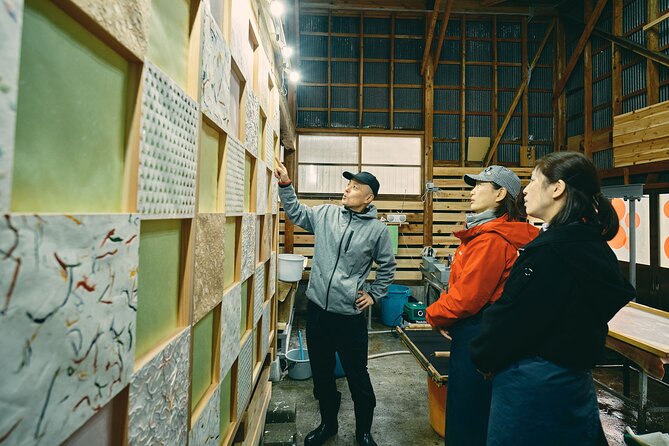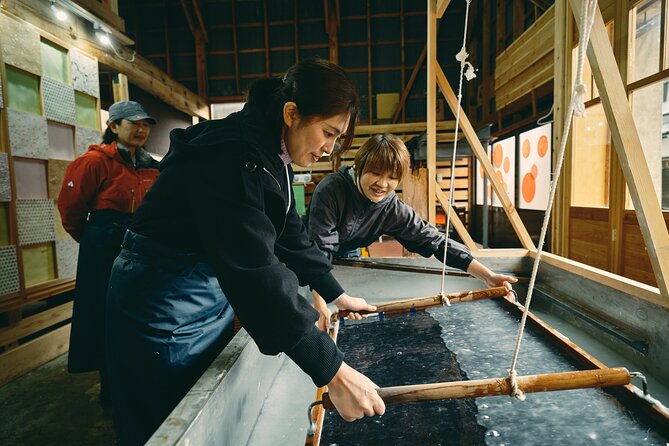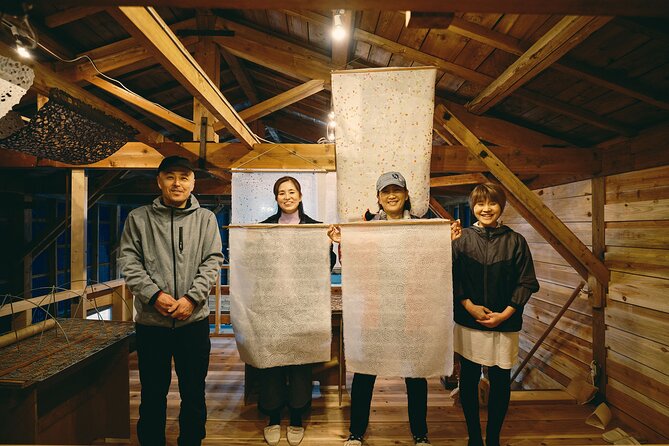Discover the captivating world of washi paper at the Ryozo Yanase Washi Paper Mill in Japan’s Fukui Prefecture. This family-owned mill invites visitors to enjoy the intricate process, from harvesting raw materials to crafting bespoke sheets. Under the guidance of skilled artisans, you’ll personalize your creations using natural fibers and decorative elements, forging a connection to centuries-old traditions. Prepare to be enchanted by the serene atmosphere and the enduring cultural heritage of this timeless craft.
Key Points

-
Participate in a private guided tour of the Ryozo Yanase Washi Paper Mill, where you can witness the intricate, centuries-old process of handcrafted washi papermaking.
-
Engage with skilled artisans who will teach you the traditional techniques, from harvesting raw materials to forming and drying the paper sheets.
-
Customize your own unique washi paper by selecting natural fibers, textures, and colors, and incorporating dried elements to reflect your personal style.
-
Enjoy the serene atmosphere of the mill, which enhances the authentic experience of this cultural heritage craft.
-
Gain a deeper appreciation for the craftsmanship and sustainable practices that have been passed down through generations, ensuring the preservation of the washi papermaking tradition.
Overview of Ryozo Yanase Washi Paper Mill

The Ryozo Yanase Washi Paper Mill nestles in the heart of Fukui Prefecture, Japan, offering visitors a captivating glimpse into the centuries-old tradition of handcrafted washi papermaking.
This family-owned mill, led by the skilled artisan Ryozo Yanase, has been preserving the art of washi production for generations.
Visitors can witness the intricate process firsthand, from harvesting the raw materials to carefully forming and drying the delicate sheets of paper.
The mill’s serene atmosphere and the dedication of its craftspeople create a truly immersive and authentic experience, transporting guests back in time to the roots of this revered Japanese craft.
You can also read our reviews of more private tours in Fukui Prefecture
History and Tradition of Washi Papermaking
Washi paper, a unique and time-honored Japanese craft, boasts a rich history that stretches back centuries. This traditional papermaking technique, passed down through generations, relies on the delicate fibers of the kozo, mitsumata, and gampi plants. The intricate process transforms these natural materials into exceptionally strong and supple sheets, each imbued with its own distinct character.
| Plant | Fiber Length | Fiber Thickness | Strength | Sheen |
|---|---|---|---|---|
| Kozo | Long | Thick | High | Low |
| Mitsumata | Medium | Thin | Medium | High |
| Gampi | Short | Thin | Low | High |
The meticulous attention to detail and the celebration of imperfections inherent in washi papermaking imbue each sheet with a tangible sense of authenticity and cultural heritage.
The Washi Paper Making Process
Four essential steps comprise the intricate washi paper making process.
Artisans first collect kozo, gampi, or mitsumata fibers, then boil them to separate the pulp.
Next, they pour the pulp into a wooden frame, allowing the fibers to interlock as water drains.
Finally, the paper is hung to dry, creating unique textures and patterns.
The craftsmanship is truly remarkable:
- Fibers are painstakingly selected and prepared.
- The pulp is delicately formed into sheets.
- Drying techniques impart the paper’s distinctive qualities.
This centuries-old tradition results in the exceptional washi paper that’s both functional and beautiful.
Customizing Your Washi Paper
After mastering the core washi paper making techniques, artisans at the RYOZO Yanase Washi Paper Mill invite guests to customize their own unique sheets.
Participants can select from an array of natural fibers, textures, and colors to create personalized washi paper. The experienced staff guides visitors through the customization process, offering suggestions on how to achieve desired effects.
Guests may incorporate dried flowers, leaves, or other natural materials into their handcrafted paper. This hands-on experience allows visitors to infuse their personal style and creativity into the centuries-old tradition of Japanese washi paper making.
Experiencing the Art of Washi Paper Crafting
Guests visiting the RYOZO Yanase Washi Paper Mill in Fukui Prefecture, Japan, are invited to immerse themselves in the timeless art of washi paper crafting.
Under the guidance of skilled artisans, participants embark on a private, hands-on experience to create their own unique washi paper masterpieces.
The process involves:
- Selecting handmade washi paper and natural materials.
- Learning traditional papermaking techniques like pulp mixing, sheet forming, and drying.
- Personalizing their creations with decorative elements like pigments, stamps, or pressed flowers.
Crafting washi paper is a captivating journey that allows guests to connect with Japan’s rich cultural heritage.
- Making of Echizen Lacquerware and Lacquering Tray Experience
- Personalize Your Own Knife and Visit Knife Handle Making Factory
- Guided Kayak Tour Unveiling the History of the Lake Suigetsuko
- Private Art Craft Pottery Activity at Echizen
- Private Making Your Own Unique Sunglass in Sabae Fukui
- Experience Tasting Fukuis Local Sake in a Lacquered Glass
Exploring the Unique Qualities of Washi Paper
Washi paper, a centuries-old Japanese craft, captivates with its unique qualities that set it apart from mass-produced counterparts.
The delicate fibers, harvested from native plants like mulberry and bamboo, lend a distinctive texture and durability to each sheet. The artisanal process, passed down through generations, infuses every piece with a sense of tradition and authenticity.
Whether used for calligraphy, origami, or interior design, washi paper‘s natural beauty and versatility shine through. Its earthy tones and gentle sheen evoke the tranquility of the Japanese countryside, making it a sought-after medium for those seeking a connection to time-honored craftsmanship.
Insights From the Master Washi Papermaker

As the master washi papermaker welcomed visitors into the private mill, their eyes widened at the captivating process unfolding before them.
With practiced hands, the artisan skillfully manipulated the delicate fibers, layering them with precision to create sheets of exquisite paper.
The visitors learned:
- The importance of using local, sustainably-sourced materials to preserve the authentic tradition of washi.
- The meticulous techniques required to achieve the paper’s distinctive texture and strength.
- The deep cultural significance of washi, woven into the fabric of Japanese heritage.
The visitors left the mill with a newfound appreciation for the mastery and dedication of the washi papermaker.
Bringing Home Your Handmade Washi Masterpiece
As the private tour drew to a close, the visitors couldn’t wait to bring home their very own handmade washi masterpiece. The master papermaker guided them through the final steps, ensuring each sheet was carefully pressed and dried. Excitement built as they carefully wrapped their precious creations.
| What to Expect | Washi Paper Mill | Your Handmade Washi |
|---|---|---|
| Personalized | Hands-on | Unique |
| Memorable | Centuries-old | Durable |
| Authentic | Traditional | Functional |
| Rewarding | Sustainable | Treasured |
Leaving the mill, the group couldn’t stop admiring their new washi keepsakes, each one a work of art infused with the history and craftsmanship of this ancient Japanese tradition.
Since You Asked
Can Participants Take Breaks During the Experience?
Participants can take breaks during the experience as needed. The private tour allows for flexibility, so they can rest and recharge at their own pace throughout the paper-making process.
What Should Participants Wear for the Activity?
Participants should wear comfortable clothing they don’t mind getting a bit messy. Closed-toe shoes are recommended, as the mill floor can be slippery. Bringing an apron or smock to protect clothing is also a good idea.
Are There Any Age Restrictions for the Experience?
There are no age restrictions for this experience. Most travelers can participate, so both children and adults are welcome to join the private tour at the Ryozo Yanase Washi Paper Mill in Fukui Prefecture, Japan.
Can Participants Purchase Additional Materials During the Activity?
Participants can purchase additional materials during the activity. The experience fee covers the basic materials needed, but travelers can choose to buy extra washi paper, tools, or other souvenirs to take home from the mill.
Is There a Minimum or Maximum Group Size for the Tour?
The tour doesn’t have a set minimum or maximum group size. It’s a private activity, so the group size can vary depending on the number of participants booked. The price per person changes based on the total group size.
The Sum Up
Immersing oneself in the serene art of washi paper making at Ryozo Yanase’s family-owned mill is a truly enriching experience. Visitors can personalize their own handcrafted sheets, connecting to centuries-old traditions through the guidance of dedicated artisans. The unique qualities of washi paper—its strength, texture, and natural beauty—make for a remarkable memento, inspiring a deeper appreciation for this cultural heritage.
More Private Tours in Fukui Prefecture
- Private Echizen Lacquer Painting Experience and Cycling Tour
- Private Woodworking and Lacquerware Session for Crafting Spoon
- Private Making Your Own Unique Sunglass in Sabae Fukui
- Private Art Craft Pottery Activity at Echizen
- Private Echizen Washi Paper Making Experience and Walking Tour
- Tsuruga Private Customizable Full Day Tour
More Tour Reviews in Fukui Prefecture
- Fukui Sake Brewery Tour and Traditional Craft Experience
- Echizen Lacquerware and Washi Paper Craft Tour
- Culinary Journey With Traditional Fishing Method Tour
- Private Echizen Lacquer Painting Experience and Cycling Tour
- Onigawara and Echizen Tiles Activity
- Craft Washi and Uchiwa Fan Making Echizen Washi Village Tour
Not for you? Here's more nearby things to do in Fukui Prefecture we have reviewed
- Fukui Sake Brewery Tour and Traditional Craft Experience
- Echizen Lacquerware and Washi Paper Craft Tour
- Culinary Journey With Traditional Fishing Method Tour
- Private Echizen Lacquer Painting Experience and Cycling Tour
- Onigawara and Echizen Tiles Activity
- Craft Washi and Uchiwa Fan Making Echizen Washi Village Tour
- Private Woodworking and Lacquerware Session for Crafting Spoon
- Spirit of Craftsmanship in Japanese Papermaking in Echizen
- Experience Tasting Fukuis Local Sake in a Lacquered Glass
- Private Making Your Own Unique Sunglass in Sabae Fukui
- Private Art Craft Pottery Activity at Echizen
